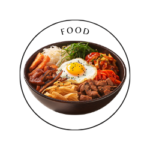 Mind
Mind
- Digital and Modern Well-being
- Mental Health and Emotional Well-being
- Mind-Body Connection and Holistic Health
- Parenting and Family
- Personal Growth and Development
- Relationships and Social Well-being
- Stress and Relaxation
- Therapeutic and Creative Practices
- Trauma and Recovery
- Work, Productivity, and Discipline
 Body
Body
 Fitness
Fitness
 Food
Food
 Beauty
Beauty
Cooking Techniques for Beginners

Cooking Techniques for Beginners: Master the Basics with Confidence
From Clueless to Confident in the Kitchen
Cooking doesn’t have to feel overwhelming. Mastering a few basic techniques will give you the confidence to whip up delicious meals without relying on takeout or pre-made options. Let’s break down the essential cooking methods every beginner should know—so next time you’re in the kitchen, you can cook with ease instead of second-guessing yourself.
Essential Cooking Techniques for Beginners
1. Boiling: The Gateway to Cooking
Boiling is one of the simplest cooking techniques—it just requires water and heat. Perfect for pasta, potatoes, eggs, and vegetables, boiling is all about submerging food in hot, bubbling water until it reaches the right texture.
👩🍳 How to Do It Right:
- Use a large pot with plenty of water to prevent overcrowding.
- Salt the water before boiling pasta or vegetables—it enhances flavour.
- For eggs, start in cold water and bring to a boil for even cooking.
💡 Tip: Want firmer pasta? Cook it al dente (slightly firm to the bite).
2. Sautéing: Quick & Flavorful
Sautéing means cooking food quickly over medium-high heat in a small amount of oil or butter. It’s great for vegetables, chicken strips, shrimp, and mushrooms—anything that benefits from a light sear.
👩🍳 How to Do It Right:
- Use a wide pan to avoid overcrowding (which causes steaming, not sautéing).
- Heat oil or butter first—when it shimmers, it’s ready.
- Stir frequently for even cooking, but not too much or you’ll prevent browning.
💡 Tip: Use olive oil for flavour, vegetable oil for high-heat cooking.
3. Roasting: The Secret to Crispy, Caramelised Goodness
Roasting uses dry heat in an oven to cook food evenly while enhancing its natural flavours. It’s perfect for chicken, potatoes, carrots, and root vegetables—anything that benefits from a crispy exterior and tender inside.
👩🍳 How to Do It Right:
- Preheat the oven to 180–220°C (350–425°F) for best results.
- Use a light coating of oil to help browning.
- Arrange food in a single layer—no stacking, or it’ll steam instead of roast.
💡 Tip: Flip food halfway through cooking for even crispiness.
4. Baking: More Than Just Cakes & Cookies
Baking isn’t just for desserts—it’s also used for bread, casseroles, and even meats like salmon or chicken. It involves surrounding food with dry heat in an oven for a controlled, even cook.
👩🍳 How to Do It Right:
- Always preheat the oven before baking.
- Use baking paper (parchment paper) to prevent sticking.
- Keep the oven door closed as much as possible—heat loss affects cooking time.
💡 Tip: For tender, moist baked chicken, cover it loosely with foil for half the cooking time, then uncover for a golden brown finish.
5. Grilling: Bold, Smoky Flavours
Grilling cooks food quickly over direct heat, whether on a stovetop grill pan or an outdoor barbecue. It’s great for steaks, burgers, fish, and vegetables like bell peppers and zucchini.
👩🍳 How to Do It Right:
- Preheat the grill until hot to get good sear marks.
- Lightly oil the food, not the grill—this prevents sticking.
- Don’t press down on meat while cooking—it loses juices and dries out.
💡 Tip: Use tongs instead of a fork to flip meat—piercing it releases juices.
6. Stir-Frying: High Heat, Fast Cooking
Stir-frying is like sautéing but at higher heat, using constant stirring to keep food moving. This technique is great for quick meals with vegetables, tofu, or thinly sliced meats.
👩🍳 How to Do It Right:
- Use a wok or large frying pan for even heat distribution.
- Cook in batches—crowding the pan lowers temperature and causes sogginess.
- Add sauce last to coat ingredients evenly without burning.
💡 Tip: Prep all ingredients before cooking—stir-frying moves fast!
7. Steaming: The Healthiest Cooking Method
Steaming cooks food using moist heat from boiling water, preserving nutrients better than boiling. It’s perfect for broccoli, fish, dumplings, and even eggs.
👩🍳 How to Do It Right:
- Use a steamer basket over simmering water—don’t let food touch the water.
- Keep a lid on to trap steam.
- For extra flavour, add herbs, lemon, or garlic to the water.
💡 Tip: Don’t over-steam veggies—they should be vibrant, not mushy.
Common Cooking Mistakes (and How to Fix Them!)
🚫 Overcrowding the pan → Food steams instead of browning.
✅ Use a bigger pan or cook in batches.
🚫 Cutting meat right after cooking → Juices escape, making it dry.
✅ Let meat rest for 5–10 minutes before slicing.
🚫 Using cold meat straight from the fridge → Uneven cooking.
✅ Let meat sit at room temperature for 15 minutes before cooking.
🚫 Not tasting as you cook → Bland food.
✅ Season gradually and adjust flavours as you go.
Final Thoughts: Just Start Cooking!
Cooking isn’t about perfection—it’s about practice. Start with a simple technique, experiment with ingredients, and have fun. Even the best chefs started as beginners!
What’s Next? Try These Beginner-Friendly Recipes!
👨🍳 Roasted Vegetables with Garlic & Olive Oil
🔥 Easy 10-Minute Stir-Fry
🥚 Perfect Soft-Boiled Eggs
Mastering basic techniques today will open up a world of possibilities in the kitchen tomorrow. So grab a pan, start sautéing, and enjoy the journey!
